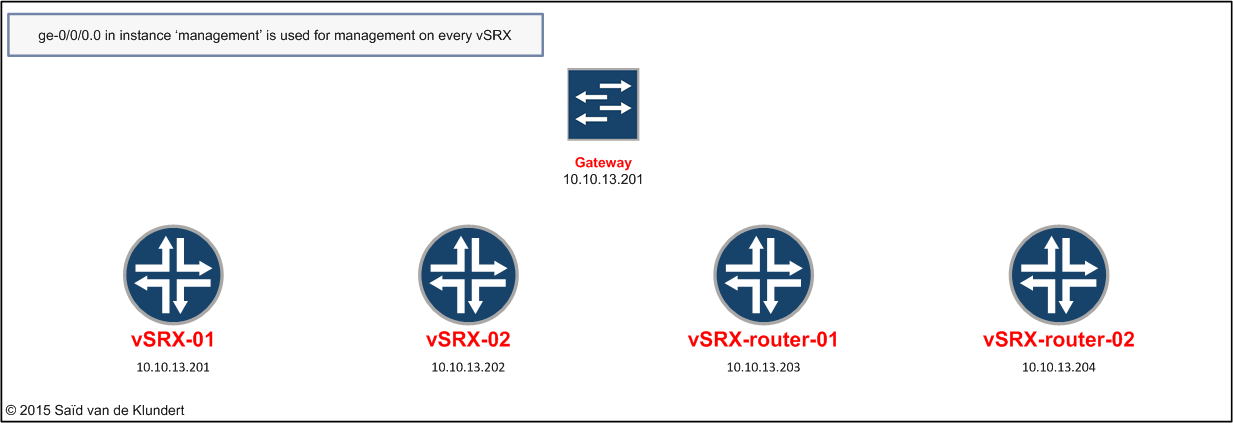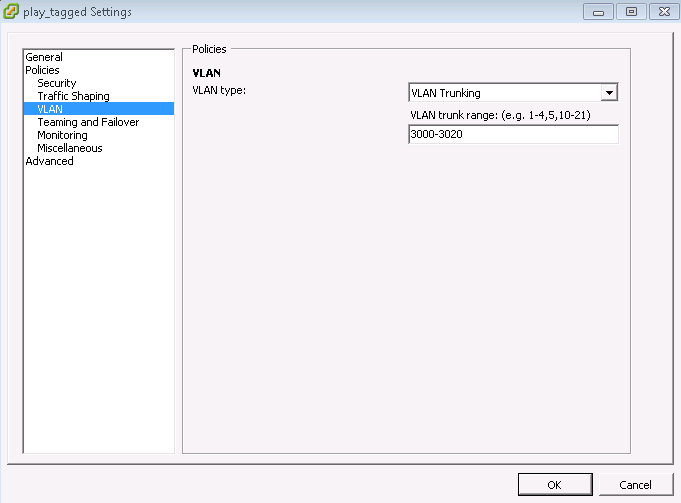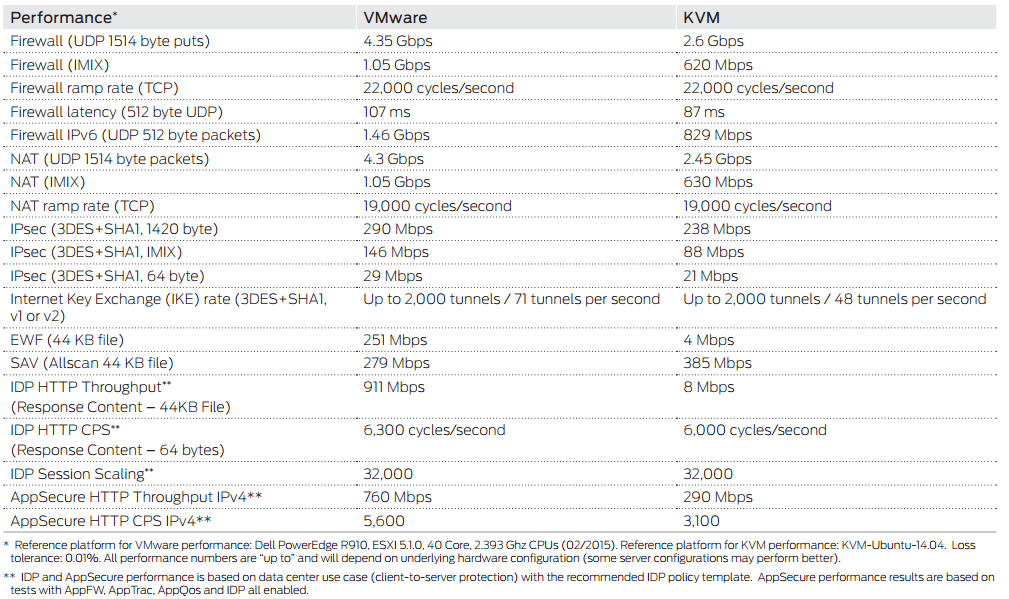Recently, I’ve been having some fun with the vSRX. I wanted to share the lab I created so others can see how easy it is to get things going with the vSRX. The vSRX doesn’t require a lot of resources and it is a really nice way to get acquainted with both the routing and firewalling capabilities that Junos has to offer. Labbing with a vSRX allows you to quickly test and play with routing-protocols (OSPF(v3), IS-IS, BGP), stateful firewalling, NAT, IPsec or even MPLS. This guide offers an insight into how you can setup a lab and it will provide you with some basic configurations to get started yourself.
I used several x3550 hosts, running ESXi, connected to a switch (EX4200):

The lab contains two firewalls and two routers. Each vSRX runs OSPF3 to distribute prefix information for both IPv4 and IPv6:

The vSRX-01 and vSRX-02 are used for firewalling. In between the firewalls, there are the vSRX-router-01 and the vSRX-router-02. These have the flow forwarding mode set to ‘packet based’ instead of ‘flow based’ (basically turning them into routers).
On every vSRX, the first vNIC (ge-0/0/0, not in the picture) was placed into an untagged port-group and it was configured with a management IP:

All other vSRX interfaces (ge-0/0/1 and ge-0/0/2) were placed into a port-group that was tagged:

To deploy the SRX in VMware, go to File > deploy OVF Template > next > next > accept > next > name the VM > next > select cluster > select resource pool > select storage > thin provision it > next (add vNICs and networks later) and finish.
After the VM is created, edit the VM. Add two vNICs so you’ll have a total of three interfaces. Put the first vNIC in the management port-group and place the rest into the tagged port-group. Press start and wait for Junos.
When you boot the vSRX in Vmware for the first time, you can only access it via the console screen. To be able to quickly copy-paste the configuration into the vSRX, the vSRX will need to have an IP address and it needs to be configured for telnet/ssh access. To avoid too much typing, simply make 1 vSRX managable like this:
root cli configure delete set system host-name vSRX set system root-authentication plain-text-password playplay1 set system login user play uid 9999 set system login user play class super-user set system login user play authentication plain-text-password playplay1 set system services telnet set interfaces ge-0/0/0 unit 0 family inet address 10.10.13.200/24 set security zones functional-zone management interfaces ge-0/0/0.0 host-inbound-traffic system-services telnet commit and-quit
Power down this first vSRX and clone it 3 times. Then boot the VMs one by one and copy paste the configuration below into the vSRX:
vSRX-01:
delete set system host-name vSRX-01 set system root-authentication encrypted-password "$1$brjswqXa$/5315/zMuQuIiUu8kQT8U/" set system login user play uid 9999 set system login user play class super-user set system login user play authentication encrypted-password "$1$Z/K/ZEGJ$ydYmwT99wlfVJXgy8ZBhn." set system services ssh set system services telnet set system syslog user * any emergency set system syslog file messages any any set system syslog file messages authorization info set system syslog file interactive-commands interactive-commands any set interfaces ge-0/0/0 description mgmt set interfaces ge-0/0/0 unit 0 family inet address 10.10.13.201/24 set interfaces ge-0/0/1 vlan-tagging set interfaces ge-0/0/1 unit 3009 description vSRX-router-01 set interfaces ge-0/0/1 unit 3009 vlan-id 3009 set interfaces ge-0/0/1 unit 3009 family inet address 192.168.50.2/30 set interfaces ge-0/0/1 unit 3009 family inet6 address 2001:db8::0/127 set interfaces ge-0/0/2 vlan-tagging set interfaces ge-0/0/2 unit 3001 description VM set interfaces ge-0/0/2 unit 3001 vlan-id 3001 set interfaces ge-0/0/2 unit 3001 family inet address 172.16.0.1/24 set interfaces ge-0/0/2 unit 3001 family inet6 address 2001:db8:1::1/64 set interfaces lo0 unit 0 family inet address 192.168.1.1/32 primary set interfaces lo0 unit 0 family inet6 set routing-options router-id 192.168.1.1 set protocols ospf3 realm ipv4-unicast area 0.0.0.0 interface ge-0/0/1.3009 interface-type p2p set protocols ospf3 realm ipv4-unicast area 0.0.0.0 interface lo0.0 passive set protocols ospf3 realm ipv4-unicast area 0.0.0.0 interface ge-0/0/2.3001 passive set protocols ospf3 area 0.0.0.0 interface ge-0/0/1.3009 interface-type p2p set protocols ospf3 area 0.0.0.0 interface lo0.0 passive set protocols ospf3 area 0.0.0.0 interface ge-0/0/2.3001 passive set security forwarding-options family inet6 mode flow-based set security zones functional-zone management interfaces ge-0/0/0.0 host-inbound-traffic system-services telnet set security zones functional-zone management interfaces ge-0/0/0.0 host-inbound-traffic system-services ssh set security zones security-zone wan interfaces ge-0/0/1.3009 host-inbound-traffic system-services ping set security zones security-zone wan interfaces ge-0/0/1.3009 host-inbound-traffic protocols ospf3 set security zones security-zone wan interfaces lo0.0 host-inbound-traffic system-services ping set security zones security-zone lan interfaces ge-0/0/2.3001 host-inbound-traffic system-services ping set security zones security-zone lan interfaces ge-0/0/2.3001 host-inbound-traffic system-services dhcp set routing-instances management instance-type virtual-router set routing-instances management interface ge-0/0/0.0 set routing-instances management routing-options static route 0.0.0.0/0 next-hop 10.10.13.1 set applications application junos-telnet inactivity-timeout never set applications application junos-ssh inactivity-timeout never
vSRX-02:
delete set system host-name vSRX-02 set system root-authentication encrypted-password "$1$brjswqXa$/5315/zMuQuIiUu8kQT8U/" set system login user play uid 9999 set system login user play class super-user set system login user play authentication encrypted-password "$1$Z/K/ZEGJ$ydYmwT99wlfVJXgy8ZBhn." set system services ssh set system services telnet set system syslog user * any emergency set system syslog file messages any any set system syslog file messages authorization info set system syslog file interactive-commands interactive-commands any set interfaces ge-0/0/0 description mgmt set interfaces ge-0/0/0 unit 0 family inet address 10.10.13.202/24 set interfaces ge-0/0/1 vlan-tagging set interfaces ge-0/0/1 unit 3011 description vSRX-router-02 set interfaces ge-0/0/1 unit 3011 vlan-id 3011 set interfaces ge-0/0/1 unit 3011 family inet address 192.168.50.6/30 set interfaces ge-0/0/1 unit 3011 family inet6 address 2001:db8::5/127 set interfaces ge-0/0/2 vlan-tagging set interfaces ge-0/0/2 unit 3002 description VM set interfaces ge-0/0/2 unit 3002 vlan-id 3002 set interfaces ge-0/0/2 unit 3002 family inet address 172.16.1.1/24 set interfaces ge-0/0/2 unit 3002 family inet6 set interfaces lo0 unit 0 family inet address 192.168.1.2/32 set interfaces lo0 unit 0 family inet6 set routing-options router-id 192.168.1.2 set protocols ospf3 realm ipv4-unicast area 0.0.0.0 interface ge-0/0/1.3011 interface-type p2p set protocols ospf3 realm ipv4-unicast area 0.0.0.0 interface lo0.0 passive set protocols ospf3 realm ipv4-unicast area 0.0.0.0 interface ge-0/0/2.3002 passive set protocols ospf3 area 0.0.0.0 interface ge-0/0/1.3011 interface-type p2p set protocols ospf3 area 0.0.0.0 interface lo0.0 passive set protocols ospf3 area 0.0.0.0 interface ge-0/0/2.3002 passive set security forwarding-options family inet6 mode flow-based set security policies from-zone wan to-zone wan policy 1 description allow-ping-to-loopback set security policies from-zone wan to-zone wan policy 1 match source-address any-ipv4 set security policies from-zone wan to-zone wan policy 1 match destination-address loopback set security policies from-zone wan to-zone wan policy 1 match application junos-ping set security policies from-zone wan to-zone wan policy 1 then permit set security zones functional-zone management interfaces ge-0/0/0.0 host-inbound-traffic system-services telnet set security zones functional-zone management interfaces ge-0/0/0.0 host-inbound-traffic system-services ssh set security zones security-zone wan address-book address loopback 192.168.1.2/32 set security zones security-zone wan interfaces ge-0/0/1.3011 host-inbound-traffic system-services ping set security zones security-zone wan interfaces ge-0/0/1.3011 host-inbound-traffic protocols ospf3 set security zones security-zone wan interfaces lo0.0 host-inbound-traffic system-services ping set security zones security-zone lan interfaces ge-0/0/2.3002 set routing-instances management instance-type virtual-router set routing-instances management interface ge-0/0/0.0 set routing-instances management routing-options static route 0.0.0.0/0 next-hop 10.10.13.1 set applications application junos-telnet inactivity-timeout never set applications application junos-ssh inactivity-timeout never
vSRX-router-01:
delete set system host-name vSRX-router-01 set system root-authentication encrypted-password "$1$brjswqXa$/5315/zMuQuIiUu8kQT8U/" set system login user play uid 9999 set system login user play class super-user set system login user play authentication encrypted-password "$1$Z/K/ZEGJ$ydYmwT99wlfVJXgy8ZBhn." set system services ssh set system services telnet set system syslog user * any emergency set system syslog file messages any any set system syslog file messages authorization info set system syslog file interactive-commands interactive-commands any set interfaces ge-0/0/0 description mgmt set interfaces ge-0/0/0 unit 0 family inet address 10.10.13.203/24 set interfaces ge-0/0/1 vlan-tagging set interfaces ge-0/0/1 unit 3009 description vSRX-01 set interfaces ge-0/0/1 unit 3009 vlan-id 3009 set interfaces ge-0/0/1 unit 3009 family inet address 192.168.50.1/30 set interfaces ge-0/0/1 unit 3009 family inet6 address 2001:db8::1/127 set interfaces ge-0/0/2 vlan-tagging set interfaces ge-0/0/2 unit 3010 description vSRX-router-02 set interfaces ge-0/0/2 unit 3010 vlan-id 3010 set interfaces ge-0/0/2 unit 3010 family inet address 10.1.0.1/30 set interfaces ge-0/0/2 unit 3010 family inet6 address 2001:db8::2/127 set interfaces lo0 unit 0 family inet address 10.0.0.1/32 set interfaces lo0 unit 0 family inet6 set routing-options router-id 10.0.0.1 set protocols ospf3 realm ipv4-unicast area 0.0.0.0 interface ge-0/0/2.3010 interface-type p2p set protocols ospf3 realm ipv4-unicast area 0.0.0.0 interface ge-0/0/1.3009 interface-type p2p set protocols ospf3 realm ipv4-unicast area 0.0.0.0 interface lo0.0 passive set protocols ospf3 area 0.0.0.0 interface ge-0/0/2.3010 interface-type p2p set protocols ospf3 area 0.0.0.0 interface ge-0/0/1.3009 interface-type p2p set protocols ospf3 area 0.0.0.0 interface lo0.0 passive set security forwarding-options family inet6 mode packet-based set security forwarding-options family mpls mode packet-based set routing-instances management instance-type virtual-router set routing-instances management interface ge-0/0/0.0 set routing-instances management routing-options static route 0.0.0.0/0 next-hop 10.10.13.1
vSRX-router-02:
delete set system host-name vSRX-router-02 set system root-authentication encrypted-password "$1$brjswqXa$/5315/zMuQuIiUu8kQT8U/" set system login user play uid 9999 set system login user play class super-user set system login user play authentication encrypted-password "$1$Z/K/ZEGJ$ydYmwT99wlfVJXgy8ZBhn." set system services ssh set system services telnet set system syslog user * any emergency set system syslog file messages any any set system syslog file messages authorization info set system syslog file interactive-commands interactive-commands any set interfaces ge-0/0/0 description mgmt set interfaces ge-0/0/0 unit 0 family inet address 10.10.13.204/24 set interfaces ge-0/0/1 vlan-tagging set interfaces ge-0/0/1 unit 3011 description vSRX-02 set interfaces ge-0/0/1 unit 3011 vlan-id 3011 set interfaces ge-0/0/1 unit 3011 family inet address 192.168.50.5/30 set interfaces ge-0/0/1 unit 3011 family inet6 address 2001:db8::4/127 set interfaces ge-0/0/2 vlan-tagging set interfaces ge-0/0/2 unit 3010 description vSRX-router-01 set interfaces ge-0/0/2 unit 3010 vlan-id 3010 set interfaces ge-0/0/2 unit 3010 family inet address 10.1.0.2/30 set interfaces ge-0/0/2 unit 3010 family inet6 address 2001:db8::3/127 set interfaces ge-0/0/2 unit 3010 family inet6 address 2001:db8:2::1/64 set interfaces lo0 unit 0 family inet address 10.0.0.2/32 set interfaces lo0 unit 0 family inet6 set routing-options router-id 10.0.0.2 set protocols ospf3 realm ipv4-unicast area 0.0.0.0 interface ge-0/0/2.3010 interface-type p2p set protocols ospf3 realm ipv4-unicast area 0.0.0.0 interface ge-0/0/1.3011 interface-type p2p set protocols ospf3 realm ipv4-unicast area 0.0.0.0 interface lo0.0 passive set protocols ospf3 area 0.0.0.0 interface ge-0/0/1.3011 interface-type p2p set protocols ospf3 area 0.0.0.0 interface ge-0/0/2.3010 interface-type p2p set protocols ospf3 area 0.0.0.0 interface lo0.0 passive set security forwarding-options family inet6 mode packet-based set security forwarding-options family mpls mode packet-based set routing-instances management instance-type virtual-router set routing-instances management interface ge-0/0/0.0 set routing-instances management routing-options static route 0.0.0.0/0 next-hop 10.10.13.1
After a commit and-quit on every vSRX, reset all of them and check the following:
play@vSRX-01> ping source 192.168.1.1 192.168.1.2 rapid PING 192.168.1.2 (192.168.1.2): 56 data bytes !!!!! --- 192.168.1.2 ping statistics --- 5 packets transmitted, 5 packets received, 0% packet loss round-trip min/avg/max/stddev = 15.037/18.973/20.195/1.974 ms play@vSRX-02> show security flow session destination-prefix 192.168.1.2 Session ID: 49816, Policy name: 1/4, Timeout: 2, Valid In: 192.168.1.1/0 --> 192.168.1.2/39187;icmp, If: ge-0/0/1.3011, Pkts: 1, Bytes: 84 Out: 192.168.1.2/39187 --> 192.168.1.1/0;icmp, If: .local..0, Pkts: 1, Bytes: 84
This lab is nothing really groundbreaking, but it offers a nice start to get into the vSRX. It is easy to expand the lab start playing with different scenarios. A last example where I make it possible for two VM's to ping each other:
vSRX-01:
set interfaces ge-0/0/2 unit 3001 description VM set interfaces ge-0/0/2 unit 3001 vlan-id 3001 set interfaces ge-0/0/2 unit 3001 family inet address 172.16.0.1/24 set interfaces ge-0/0/2 unit 3001 family inet6 set security zones security-zone lan address-book address lan-hosts range-address 172.16.1.2 to 172.16.1.45 set system services dhcp pool 172.16.0.0/24 address-range low 172.16.0.2 set system services dhcp pool 172.16.0.0/24 address-range high 172.16.0.45 set system services dhcp pool 172.16.0.0/24 domain-name play.play set system services dhcp pool 172.16.0.0/24 name-server 8.8.4.4 set system services dhcp pool 172.16.0.0/24 router 172.16.0.1 set system services dhcp pool 172.16.0.0/24 default-lease-time 36000 set security zones security-zone lan interfaces ge-0/0/2.3001 host-inbound-traffic system-services dhcp set protocols ospf3 realm ipv4-unicast area 0.0.0.0 interface ge-0/0/2.3001 passive set protocols ospf3 area 0.0.0.0 interface ge-0/0/2.3001 passive set security zones security-zone lan interfaces ge-0/0/2.3001 host-inbound-traffic system-services ping set security zones security-zone lan interfaces ge-0/0/2.3001 host-inbound-traffic system-services dhcp set security policies from-zone wan to-zone lan policy 1 description allow-ping-all-to-dhcp-range set security policies from-zone wan to-zone lan policy 1 match source-address any-ipv4 set security policies from-zone wan to-zone lan policy 1 match destination-address lan-hosts set security policies from-zone wan to-zone lan policy 1 match application junos-ping set security policies from-zone wan to-zone lan policy 1 then permit set security policies from-zone lan to-zone wan policy 1 description allow-ping set security policies from-zone lan to-zone wan policy 1 match source-address lan-hosts set security policies from-zone lan to-zone wan policy 1 match destination-address any-ipv4 set security policies from-zone lan to-zone wan policy 1 match application junos-ping set security policies from-zone lan to-zone wan policy 1 then permit
vSRX-02:
set interfaces ge-0/0/2 unit 3002 description VM set interfaces ge-0/0/2 unit 3002 vlan-id 3002 set interfaces ge-0/0/2 unit 3002 family inet address 172.16.1.1/24 set interfaces ge-0/0/2 unit 3002 family inet6 set security zones security-zone lan address-book address lan-hosts range-address 172.16.1.2 to 172.16.1.45 set system services dhcp pool 172.16.1.0/24 address-range low 172.16.1.2 set system services dhcp pool 172.16.1.0/24 address-range high 172.16.1.45 set system services dhcp pool 172.16.1.0/24 domain-name play.play set system services dhcp pool 172.16.1.0/24 name-server 8.8.4.4 set system services dhcp pool 172.16.1.0/24 router 172.16.1.1 set system services dhcp pool 172.16.1.0/24 default-lease-time 36000 set security zones security-zone lan interfaces ge-0/0/2.3002 host-inbound-traffic system-services dhcp set protocols ospf3 realm ipv4-unicast area 0.0.0.0 interface ge-0/0/2.3002 passive set protocols ospf3 area 0.0.0.0 interface ge-0/0/2.3002 passive set security zones security-zone lan interfaces ge-0/0/2.3002 host-inbound-traffic system-services ping set security zones security-zone lan interfaces ge-0/0/2.3002 host-inbound-traffic system-services dhcp set security policies from-zone wan to-zone lan policy 1 description allow-ping-all-to-dhcp-range set security policies from-zone wan to-zone lan policy 1 match source-address any-ipv4 set security policies from-zone wan to-zone lan policy 1 match destination-address lan-hosts set security policies from-zone wan to-zone lan policy 1 match application junos-ping set security policies from-zone wan to-zone lan policy 1 then permit set security policies from-zone lan to-zone wan policy 1 description allow-ping set security policies from-zone lan to-zone wan policy 1 match source-address lan-hosts set security policies from-zone lan to-zone wan policy 1 match destination-address any-ipv4 set security policies from-zone lan to-zone wan policy 1 match application junos-ping set security policies from-zone lan to-zone wan policy 1 then permit
After applying this configuration, I started two VMs and I put them into an untagged port-group that matched the vlan-id I used configuring the subinterfaces of the SRX. After sending some traffic from the VM located behind vSRX-01 to the VM located on vSRX-02, I was able to observe the following:

play@vSRX-02> show security flow session destination-prefix 172.16.1.10 Session ID: 4617, Policy name: 1/5, Timeout: 2, Valid In: 172.16.0.10/42127 --> 172.16.1.10/1;icmp, If: ge-0/0/1.3011, Pkts: 1, Bytes: 60 Out: 172.16.1.10/1 --> 172.16.0.10/42127;icmp, If: ge-0/0/2.3002, Pkts: 1, Bytes: 60
Some verification commands I used:
show route terse show ospf3 neighbor show system services dhcp pool show system services dhcp binding show security flow session show security flow status show security flow session summary
I think the vSRX is more than worth your while. First of all, the vSRX runs Junos. This offers a robust and featurific platform. Besides this, the performance offered by the vSRX makes it suitable for a lot of different scenarios that do not require too much IPsec (figures came from the vSRX datasheet):

To really get into the SRX, I can recommend ‘Juniper SRX Series’ or the older 'Junos Security' from the O'Reilly Media. Other than those books, just check the Juniper website for the evaluation download here and start labbing yourself.